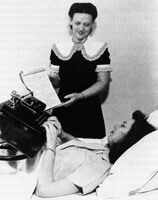Academic History (Page 1 of 2)
As a leading institution in the treatment and research of respiratory, immune and related disorders, National Jewish* has always been dedicated to educating future generations of health care providers and their patients.
In 1925, the organization began its medical education program for physicians. That year, the Colorado Medical School designated National Jewish Health as the training center in the treatment of tuberculosis (TB) and chest medicine for its students. Courses were held at National Jewish and taught by the hospital’s own medical and scientific staff.
Throughout the years, the hospital also held major conferences to learn and disseminate knowledge on certain diseases. For example, in 1955, National Jewish held the world’s first conference on the problems of TB in children—the International Symposium on Tuberculosis in Infancy and Childhood. Because of the original and much-needed contributions the experts at the conference made, the full proceedings of the symposium were published and distributed to every pediatrician, TB specialist and medical school in the United States.
Patient Education
 By the early 1930s, only 50 out of 600 or more sanatoriums in the United States offered educational and vocational training to its patients. National Jewish, however, had been providing that service since the early 1900s in order to equip patients, who often came from lives of poverty, to function more effectively in the world outside of the hospital. National Jewish Health offered a variety of classes, including English, drafting, electrical wiring and automobile repair.
By the early 1930s, only 50 out of 600 or more sanatoriums in the United States offered educational and vocational training to its patients. National Jewish, however, had been providing that service since the early 1900s in order to equip patients, who often came from lives of poverty, to function more effectively in the world outside of the hospital. National Jewish Health offered a variety of classes, including English, drafting, electrical wiring and automobile repair.
The school was progressive for its time, and instruction was individualized according to varying learning needs and physical capabilities. The emphasis was on learning through doing, encouraging the student to think for himself.
Morgridge Academy
In 1932, an in-hospital school opened on the National Jewish campus for the youngest TB patients. The Morgridge Academy (as it's called today) is a fully accredited day school for chronically ill children in kindergarten through eighth grade whose illnesses prohibit their attendance in a normal public school. From its inception, students have received individual and structured education programs to assist them in achieving academic and physical excellence and to prepare them to become independent, self reliant and responsible.
NEXT: Professional Education and Training
Page 1, 2
*Over the years, the National Jewish Health name has evolved to better communicate our mission. However, all names have included a common component –the words National Jewish. Therefore, the name National Jewish is used in all references to our institution throughout this history overview.